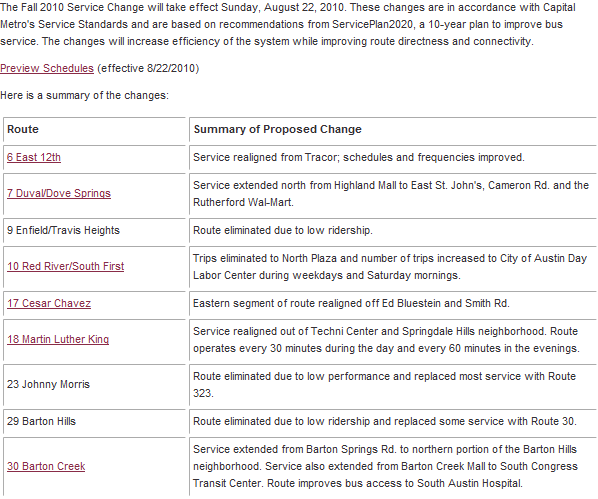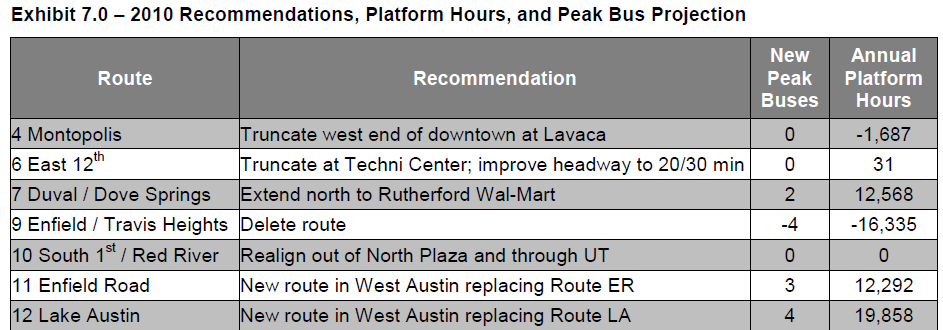So yesterday, I saw a couple of self-congratulatory tweets about the upcoming service changes (on Sunday) which start the process of eliminating service to large parts of central west Austin. This was particularly interesting given that I had just added information to our rental property’s MLS listing about “distance to MetroBus” (the #9, at least until Sunday, has a stop about 100 feet away). So here’s what I tweeted in response:

(some short background on the taxes and Red Line issue here)
Shortly thereafter, it was retweeted by another user. Capital Metro PR guy JMVC responded (to that user, not me) that the service change resulted in increased service, and that “you should take what he says with a grain of salt”. I had planned to just link to this tweet but since yesterday I’ve been blocked (JMVC has been non-public tweeting for a long time; although he certainly shares his opinions with most of the local decision-makers despite not being willing to be similarly available to the public).
Here’s the image:

So let’s examine in detail. My tweet:
Question 1: Is Clarksville losing service?
Well, they’re losing the #9. Promised in return was a reworked version of the current ER (Enfield Road) shuttle, to pick up the Clarksville portion of the #9 (the new #11 route was to leave Enfield at West Lynn just like the #9 did; run down West Lynn, turn on 12th, hit the very northern portion of downtown, and then head to UT). IF the #11 existed, one could reasonably argue that Clarksville was losing some serivce (to the core of downtown and points towards Travis Heights) but gaining other service (better access to UT area during times when the ER doesn’t currently run). Image scraped from the 2020 service plan created by Capital Metro:

The 2020 service plan explicitly mentions that the cancellation of the #9 should not occur until the #11 is ready to go. Again we go to the fine folks at Capital Metro:
So here we are in Fall of 2010. Is the #11 ready to go? Well, here’s an image of the proposed service changes (click for the source posting, which will probably age off in a month or two):

The whole thing is longer – but there’s nothing in there about the #11 or the ER. Notice that the #29 cancellation notes that the #30 modifications pick up some of the lost service; no such claim exists on the line for the #9.
So, on part 1 of the claim, that being that Clarksville is losing service, I believe we’ve proven adequately well that I was correct. Clarksville is losing the one metro route it has; the metro routes supposedly replacing nearby UT shuttle routes and the lost #9 are nowhere to be found. Anybody disagree?
Question 2: Is service overall going up? (Implied by JMVC)
Short and sweet: Here’s two images from the 2010 implementation plan for the 2020 service plan changes. Make sure your browser is wide enough to see the column titled “Annual platform hours”. Or just click on them.

[…]

-7 buses (note that the ER/LA versus 11/12 changes don’t actually change the number of buses). And note that this is the original implementation plan. Yes, hours of service theoretically goes up by 30 system-wide – but note that without the ER/LA to 11/12 change, this is more likely going to be a large decrease in hours of service (by my calculations that changes things by something like 13,000 fewer hours). 21/22 changes also not happening now (this is a good thing in the short-term); that would give back about 10,000 hours if/when it happens. Somebody with more time than me is welcome to tally up and see what the difference really is – but it’s clear the #9 resources were originally intended to go into expanding the ER and changing it into the 11, and that’s not happening now. Let’s say 5-7 fewer buses given the 2 the 21/22 would have been responsible for losing.
So what we have now is 5-7 fewer buses and about 3,000 to 13,000 fewer hours of service. The answer to the question is: NO, service overall is NOT going up as a result of this change. The resources from the #9 are NOT being invested in service elsewhere in the system.
Question 3: Why are these cuts being made?
This one is never going to be nailed down for sure – but here’s a hint as to why they might have done the “save money” part of the implementation plan and apparently deferred the “spend that saved money” part of the plan. (Click for larger image).

The most logical explanation for the failure to produce the promised #11 substitute for Clarksville is the fact that it’s a change that costs money – and right now all the available money in the system is being sucked up providing huge subsidies (far more than the huge subsidies originally budgeted) for rail riders, many of whom are from areas that don’t even pay Capital Metro taxes).
This is with the current Red Line operations. Capital Metro is now proposing more runs (different times and more days of the week). Where do you think that money is going to come from? Those trains are going to be less full than what we have today, so the subsidy per passenger is going to be going up, not down; more, not less, operations dollars will be required for rail.
If you think the decision to spend more operating costs on rail doesn’t have anything to do with the fact that this service change has kept most of the money-saving ideas but thrown out many of the money-costing ideas, you’re far more generous than am I.
Question 4: What happens now?
Do you really think people (admittedly few) who ride the #9 now are just going to stop travelling? Are they going to use the ER shuttle and just transfer to go the core of downtown? (the ER stays even further away from 6th/Congress than the proposed 11 will). Will they give up all travel entirely when UT’s not in session?
Of course not. Some of those people are going to resume driving. Some are going to find other ways around – like the long walk up/down the big hill on West Lynn to take the #21/#22 combo (slated for elimination a few years further down the road, by the way). Meaning that it’s not really acceptable to keep talking about the 11 as future relief for the 9 cancellation – the people relying on the 9 are screwed just as much this upcoming N months or years as they would be if the 11 wasn’t ever going to come along.
Question 5: Does this say anything interesting about Capital Metro?
In this process, Capital Metro’s PR guy basically told another tweeter that I shouldn’t be trusted, but failed to engage the argument in public – instead asking the other tweeter to come talk to him in private. In another forum (OWANA yahoo group), a (much nicer) employee basically did the same thing – inviting me to come to meetings to plan the future conversion of ER to 11 rather than addressing the point that, in the meantime, the neighborhood was, in fact, losing city bus service.
While it may be lame for private businesses to refuse to address the arguments of their critics in public, it is their right to do so. Is it OK for a public entity funded by our tax dollars to do the same?
This is symptomatic of the general problem with Capital Metro – every single time any of their critics makes any kind of argument, but especially when somebody makes ones that are actually good arguments, they insist on receiving input only privately (in person) or in large public settings (where every person, including people who just show up for the meeting without having any idea what they’re doing, is on an equal footing). They don’t want to engage the idea; they want to figure out how to make the person expressing the idea less of a threat so the idea itself can be safely downplayed or ignored.
Refer, please, to the repeated suggestions that because I don’t show up for the large public gatherings where lines are drawn on maps (and ignored); where suggestions are made, good and bad (and ignored); that somehow my input shouldn’t be listened to, even though, say it with me: I was right on the Red Line and they were wrong.
I think the public would benefit from an open exchange of ideas with the critics who actually want public transportation in this area – not asking for Skaggs and Daugherty to be engaged here, mind you – but Capital Metro doesn’t agree.
Cutting short now; meeting time.
Any more questions?

2014 Update
It’s January 2014 and I did a quick and dirty reformat of this post (this is one of many that did not make the transition from the old blog to the new one very well).
In 2012, I think?, Clarksville returned to service with an extension of the #18 bus, a far cheaper solution than the implementation of the #11 would have been. The area had no bus service for more than a year; the truly transit-dependent, like an employee of Fresh Plus I remember, had to move on and find other options (in his case, another job).
I just used this post on twitter as an example against the (incredibly naive, IMO) lionizing of JMVC for “accepting constructive criticism”. Reformatted where I could do so quickly to make it somewhat readable. Hope it helped.
